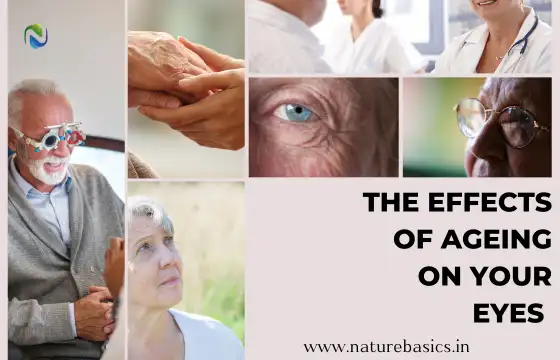The Effects of Aging on Your Eyes: From Cataracts to Macular Degeneration
Posted on 29 Apr, 2023

Just as your body ages over time, so do your eyes and vision. So if you squint your eyes while shopping or reading a book to read the ingredients of products, you are not alone. It's normal for your vision to change or deteriorate as you age. That's why you should make sure to take eye health vitamins and get regular eye exams to maintain eye health, especially if you have diabetes.
Age brings with it many changes, such as changes in the quality of your vision. In this blog, we will discuss in detail how exactly aging affects you and how you can improve your eye health.
How does aging affect eye health?
As you get older, your vision changes and you may not see as perfectly as you used to. A few common changes for older adults may include:-
Eye care is important for all ages. However, as you age, your risk of eye disease increases. Your eyes become weaker, and your health may deteriorate. That's why regular eye exams are important to detect serious eye problems. That way, you can take precautions before things get worse.
What are common eye problems associated with aging?
1. Clouding and flashes
Your eyes are made of a clear fluid or substance called vitreous gel, which allows light to pass through the retina. It also helps in maintaining the shape of eyeball. Opacities or flashes usually occur when this gel-like fluid begins to shrink with age.
Floaters are tiny dots or shoes that show up in the line of sight. Floaters appear just like dust particles that stay even after blinking eyes. They are usually harmless, but if their size, color or number increases, it may be a serious problem. It's best to see your eye doctor to get the best treatment.
Flashes, on the other hand, are bright spots or dots of light in the line of sight and can occur for a variety of reasons. The most common reason is vitreous shrinkage, where fluid begins to pull onto the retina.
2. Dry eyes
Dry eyes can become a chronic problem in adults. It occurs when the tear glands cannot produce enough tears, resulting in dry, itchy and irritated eyes.
Dry eyes can be uncomfortable and cause partial or no vision. But do not worry. An eye doctor can help relieve these symptoms by recommending eye drops to help your eyes feel better.
3. Age-related macular degeneration (AMD)
AMD is central vision eye disease. With this disease, those affected can no longer see clearly what is in front of them. It commonly occurs in adults in their fifties. Symptoms include blurred vision, straight lines that appear wavy, dark or blind spots in the center of the eye, etc.
Your eye doctor can ask about your medical history and perform eye tests, pupil dilation or visual acuity test to diagnose AMD.
4. Cataract
Cataracts are common in older adults. Nearly one in five adults over age 60 has a cataract. A cataract is a clouding and darkening of the lens of the eye that usually develops over time and affects both eyes. It can cause blurred vision, a halo around lights or poor night vision. If the cataract continues to progress, you may need surgery.
Here are some simple tips on how to keep your eyes healthy and strengthen your vision as you age: -
1. Consume antioxidant-rich foods
It's always a good move to eat healthy foods, not just for your eyes, but for your overall health and body functioning. Risk of age-related macular degeneration (AMD) is reduced by eating foods rich in vitamins C and E, zinc, lutein, zeaxanthin and omega-3 fatty acids. cataracts and perhaps even dry eyes as we age. Opt for foods rich in antioxidants, which can help lower the risk of eye disease and improve your overall health and well-being.
Let us take a look at what a nutrient-rich diet looks like?
2. Healthy omega for dry eyes
Omega-3 fatty acids are naturally found in salmon, sardines, herring, tuna, menhaden or cod liver. Women who consumed the most omega-3 fatty acids from fish had a 17% lower risk of dry eyes than women who ate little or no seafood. And a study in the International Journal of Ophthalmology concluded that omega-3 fatty acids play a distinct role in dry eye syndrome." Nuts and oils such as walnuts and sunflower oil are excellent natural sources of omega-6 fatty acids.While omega-3 helps reduce inflammation, excess omega-6 can worsen inflammation, so do not exceed the recommended dosage. Opt for Virgin Omega-3 in triple strength, which contains essential fatty acids that are important not only for eye health, but also for brain and heart health.
3. Stay hydrated
It's equally important to keep your eyes and skin hydrated. Dehydrated eyes can become dry and uncomfortable. Dehydration can even cause certain eye problems like dry eye syndrome. You should consume plenty of water and juices made from various fruits and vegetables. Green leafy vegetables and dairy products provide calcium, which can help with age-related macular degeneration (AMD)
4. Diet with low glycemic index
In diabetes, blood sugar levels can rise above the normal range, leading to serious health problems and vision loss. Foods with a high GI cause blood sugar levels to rise rapidly, while foods with a low GI cause blood sugar levels to rise more moderately, preventing a sudden spike.
People who have or are at risk for diabetes or age-related macular degeneration (AMD) may benefit from a low glycemic index diet (low GI), for example, by substituting healthy foods:
5. Schedule regular eye tests and exams
If you have passed 40, be sure to have regular eye exams. These exams are very helpful because your doctor can spot early signs of eye problems like cataracts and recommend preventive measures before the problems get too far. This is especially true for people who have had diabetes for more than a decade. Majority of vision loss from diabetes is up preventable. Early detection is key. People with diabetes should have a critical eye exam annually, even before they show signs of vision loss
Conclusion
Vision problems such as cataracts, flashes, dry eyes, etc. are common in older adults and are highly likely to occur. So they can not necessarily be prevented. But you can slow down age-related eye damage by eating a healthy diet, taking appropriate eye vitamins and maintaining lifestyle habits that help improve eye health.
Age brings with it many changes, such as changes in the quality of your vision. In this blog, we will discuss in detail how exactly aging affects you and how you can improve your eye health.
How does aging affect eye health?
As you get older, your vision changes and you may not see as perfectly as you used to. A few common changes for older adults may include:-
- You need more time to get used to changing light conditions
- Difficulty distinguishing darker colors, such as blue or green, from black
- Difficulty or inability to see at close range
Eye care is important for all ages. However, as you age, your risk of eye disease increases. Your eyes become weaker, and your health may deteriorate. That's why regular eye exams are important to detect serious eye problems. That way, you can take precautions before things get worse.
What are common eye problems associated with aging?
1. Clouding and flashes
Your eyes are made of a clear fluid or substance called vitreous gel, which allows light to pass through the retina. It also helps in maintaining the shape of eyeball. Opacities or flashes usually occur when this gel-like fluid begins to shrink with age.
Floaters are tiny dots or shoes that show up in the line of sight. Floaters appear just like dust particles that stay even after blinking eyes. They are usually harmless, but if their size, color or number increases, it may be a serious problem. It's best to see your eye doctor to get the best treatment.
Flashes, on the other hand, are bright spots or dots of light in the line of sight and can occur for a variety of reasons. The most common reason is vitreous shrinkage, where fluid begins to pull onto the retina.
2. Dry eyes
Dry eyes can become a chronic problem in adults. It occurs when the tear glands cannot produce enough tears, resulting in dry, itchy and irritated eyes.
Dry eyes can be uncomfortable and cause partial or no vision. But do not worry. An eye doctor can help relieve these symptoms by recommending eye drops to help your eyes feel better.
3. Age-related macular degeneration (AMD)
AMD is central vision eye disease. With this disease, those affected can no longer see clearly what is in front of them. It commonly occurs in adults in their fifties. Symptoms include blurred vision, straight lines that appear wavy, dark or blind spots in the center of the eye, etc.
Your eye doctor can ask about your medical history and perform eye tests, pupil dilation or visual acuity test to diagnose AMD.
4. Cataract
Cataracts are common in older adults. Nearly one in five adults over age 60 has a cataract. A cataract is a clouding and darkening of the lens of the eye that usually develops over time and affects both eyes. It can cause blurred vision, a halo around lights or poor night vision. If the cataract continues to progress, you may need surgery.
Here are some simple tips on how to keep your eyes healthy and strengthen your vision as you age: -
1. Consume antioxidant-rich foods
It's always a good move to eat healthy foods, not just for your eyes, but for your overall health and body functioning. Risk of age-related macular degeneration (AMD) is reduced by eating foods rich in vitamins C and E, zinc, lutein, zeaxanthin and omega-3 fatty acids. cataracts and perhaps even dry eyes as we age. Opt for foods rich in antioxidants, which can help lower the risk of eye disease and improve your overall health and well-being.
Let us take a look at what a nutrient-rich diet looks like?
- Vitamin C: oranges, grapefruit, kiwis, strawberries, tomatoes, red and green peppers and broccoli
- Vitamin E : avocados, almonds, olive oil and sunflower seeds,
- Zinc : Legumes (beans and lentils), seeds, meat/seafood, dairy products and eggs are good sources of zinc.
- Lutein and zeaxanthin: These two nutrients occur naturally in the retina - the light-sensitive tissue at the back of the eye. For this reason, adding lutein and zeaxanthin to your diet is a benefit to your eye health. You can find lutein and zeaxanthin in leafy green vegetables such as kale, spinach and Swiss chard, or in eye supplements. Asparagus, Broccoli, and colorful fruits like mangoes, peaches, raspberries, and papaya, are also packed with carotenoids that are healthy for eye.
2. Healthy omega for dry eyes
Omega-3 fatty acids are naturally found in salmon, sardines, herring, tuna, menhaden or cod liver. Women who consumed the most omega-3 fatty acids from fish had a 17% lower risk of dry eyes than women who ate little or no seafood. And a study in the International Journal of Ophthalmology concluded that omega-3 fatty acids play a distinct role in dry eye syndrome." Nuts and oils such as walnuts and sunflower oil are excellent natural sources of omega-6 fatty acids.While omega-3 helps reduce inflammation, excess omega-6 can worsen inflammation, so do not exceed the recommended dosage. Opt for Virgin Omega-3 in triple strength, which contains essential fatty acids that are important not only for eye health, but also for brain and heart health.
3. Stay hydrated
It's equally important to keep your eyes and skin hydrated. Dehydrated eyes can become dry and uncomfortable. Dehydration can even cause certain eye problems like dry eye syndrome. You should consume plenty of water and juices made from various fruits and vegetables. Green leafy vegetables and dairy products provide calcium, which can help with age-related macular degeneration (AMD)
4. Diet with low glycemic index
In diabetes, blood sugar levels can rise above the normal range, leading to serious health problems and vision loss. Foods with a high GI cause blood sugar levels to rise rapidly, while foods with a low GI cause blood sugar levels to rise more moderately, preventing a sudden spike.
People who have or are at risk for diabetes or age-related macular degeneration (AMD) may benefit from a low glycemic index diet (low GI), for example, by substituting healthy foods:
- Oatmeal or cereal instead of sweetened breakfast cereal
- Brown rice instead of white rice
- Eat whole-grain bread, avoid white flour bread
- Durum wheat pasta or sweet potatoes instead of baked potatoes
- Nuts instead of potato crisps
- Sweet potato over potato
- Buckwheat instead of refined flour
5. Schedule regular eye tests and exams
If you have passed 40, be sure to have regular eye exams. These exams are very helpful because your doctor can spot early signs of eye problems like cataracts and recommend preventive measures before the problems get too far. This is especially true for people who have had diabetes for more than a decade. Majority of vision loss from diabetes is up preventable. Early detection is key. People with diabetes should have a critical eye exam annually, even before they show signs of vision loss
Conclusion
Vision problems such as cataracts, flashes, dry eyes, etc. are common in older adults and are highly likely to occur. So they can not necessarily be prevented. But you can slow down age-related eye damage by eating a healthy diet, taking appropriate eye vitamins and maintaining lifestyle habits that help improve eye health.






